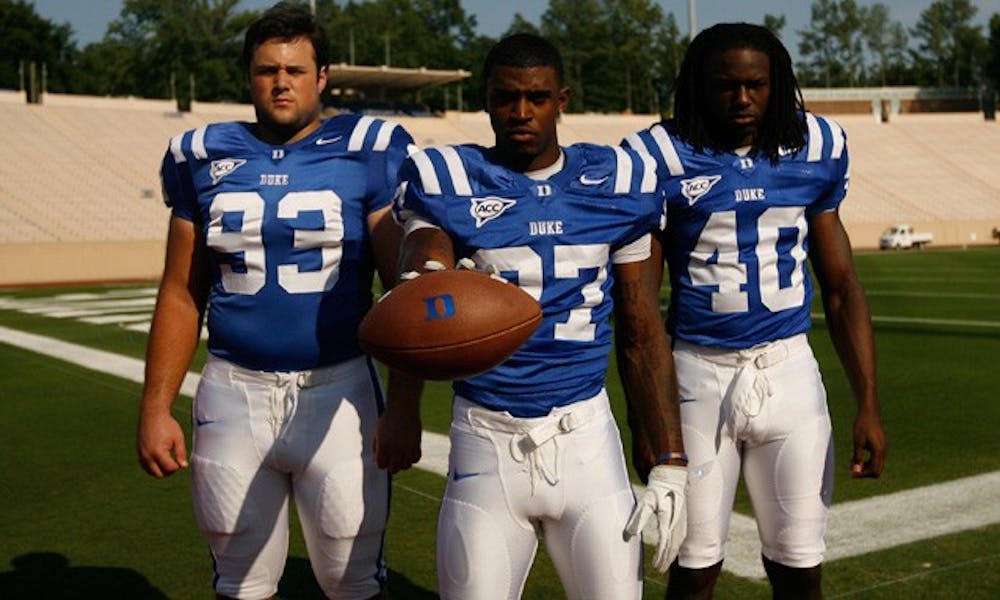By almost every statistic, Duke’s defense was abysmal last year—the Blue Devils were last in the ACC in rushing yards allowed, passing yards allowed, sacks and interceptions.
This year’s defense will differ dramatically in its scheme and substitution pattern, which the team hopes will improve its ability to stop the run and pressure the quarterback.
Duke will turn to a 4-2-5 scheme this season, a rather unorthodox system that replaces one linebacker from the typical 4-3 scheme with an extra defensive back.
First-year defensive coordinator Jim Knowles instituted a similar scheme as head coach at Cornell in 2004. The Big Red immediately jumped from worst to first in the Ivy League in yards allowed per game. After failing to win a conference game in 2003, Cornell won four in Knowles’ first year.
Although it may seem counter-intuitive to have only six men in the box while attempting to generate a more powerful rush, the extra support on the back end will allow the front six to take more risks while rushing.
“We’re playing a lot more aggressive upfield,” senior nose guard Charlie Hatcher said. “Last year it was a little bit more reading. We were really aggressive last year, but not as aggressive as this year.”
Hatcher also hopes to benefit from a more extensive rotation, which will limit the number of snaps he plays but make him more effective when he does. Although defensive line coach Rick Petri has worked extensively on improving the unit’s conditioning, they will still benefit from increased substitution because of the physical nature of the position.
While the linebackers on the field will have more freedom as a result of the new defense, the primary impact of the switch will be to hide the lack of depth at the position. Though sophomore Kelby Brown finished third in the ACC in defensive rookie of the year voting and junior Austin Gamble has shown great athleticism and flashes of potential, there is a significant drop-off in talent lower in the rotation.
The key to the scheme, however, rests with senior strong safety Matt Daniels and junior weak safety Walt Canty, who bear responsibility for reading the offensive play and communicating it to the rest of the defense.
Even more than it hides the linebackers, the 4-2-5 highlights Duke’s talent and depth at safety. The coaching staff chose to change its base defense to fit personnel strengths more than it did for any grand strategic purpose. Daniels, Canty and sophomore August Campbell, whose record-breaking 95-yard touchdown against Boston College was arguably Duke’s best play last season, are three of the team’s best athletes, and senior Lee Butler’s experience should earn him plenty of playing time. Playing a 4-2-5 gets those players more time on the field.
Daniels, whose nose for the ball and physical mentality has him only three caused fumbles away from setting a Duke record, will be asked to make his presence felt all over the field. Defensive coordinator Jim Knowles’ play calling is designed with Daniels in mind.
“You’ll see me in lots of different positions this year,” Daniels said. “Coach is putting me in a spot to align me to make more plays on the ball and just be able to fly around all over the field and use the ability that I have. He definitely sees me blitzing a lot, more in the box, playing high safety. Teams will probably never know where I’m coming from or where I’ll be. That’s what makes this defense so great.”
Whether the defense works as planned remains to be seen—last year’s failed to generate the pressure it was designed to produce. But there is reason to be optimistic about this year’s incarnation. Petri has a proven track record of developing defensive linemen, including former NFL pro-bowlers like Warren Sapp and John Abraham.
The coaching staff and players seem confident that the new scheme will ensure Duke won’t find itself in the cellar of ACC defenses again.
Get The Chronicle straight to your inbox
Signup for our weekly newsletter. Cancel at any time.

